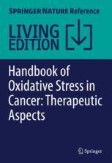Search
Search Results
-
Therapeutic Implications of Piperlongumine
Piperlongumine (PL) is a biologically active amide alkaloid natural product obtained from long pepper, Piper longum L., belonging to the Piperaceae...
-
Piperlongumine: the amazing amide alkaloid from Piper in the treatment of breast cancer
Piperlongumine (PL), an alkaloid found primarily in the fruits and roots of the plant Piper longum L. (Piperaceae), is a natural compound that...

-
Exposure of piperlongumine attenuates stemness and epithelial to mesenchymal transition phenotype with more potent anti-metastatic activity in SOX9 deficient human lung cancer cells
Phytocompounds have shown hopeful results in cancer therapy. Piperlongumine (PIP), a naturally derived bioactive alkaloid found in our dietary spice,...

-
Piperlongumine and bortezomib synergically inhibit cholangiocarcinoma via ER stress–induced cell death
Cholangiocarcinoma (CCA) is a lethal malignancy of the cholangiocytes lining the biliary tree. Only 25% of affected patients are eligible for...

-
Therapeutic Implications of Piperlongumine
Piperlongumine (PL) is a biologically active amide alkaloid natural product obtained from long pepper, Piper longum L., belonging to the Piperaceae...
-
Piperlongumine conquers temozolomide chemoradiotherapy resistance to achieve immune cure in refractory glioblastoma via boosting oxidative stress-inflamation-CD8+-T cell immunity
BackgroundThe failure of novel therapies effective in preclinical animal models largely reflects the fact that current models do not really mimic the...

-
Piperlongumine, a piper alkaloid, enhances the efficacy of doxorubicin in breast cancer: involvement of glucose import, ROS, NF-κB and lncRNAs
Piperlongumine (PL, piplartine) is an alkaloid derived from the Piper longum L. (long pepper) roots. Originally discovered in 1961, the biological...

-
Palmitoylation landscapes across human cancers reveal a role of palmitoylation in tumorigenesis
BackgroundProtein palmitoylation, which is catalyzed by palmitoyl-transferase and de-palmitoyl-transferase, plays a crucial role in various...

-
Piperlongumine potentiates the antitumor efficacy of oxaliplatin through ROS induction in gastric cancer cells
PurposeOxaliplatin is one of the most commonly used chemotherapeutic agents in the treatment of various cancers, including gastric cancer. It has,...

-
Piperlongumine Inhibits Zika Virus Replication In vitro and Promotes Up-Regulation of HO-1 Expression, Suggesting An Implication of Oxidative Stress
Owing to the widespread distribution of mosquitoes capable of transmitting Zika virus, lack of clinical vaccines and treatments, and poor immunity of...

-
Piperlongumin Improves Survival in the Mouse Model of Sepsis: Effect on Coagulation Factors and Lung Inflammation
Excessive inflammation and coagulation contribute to high morbidity and mortality in sepsis. Many studies have indicated the role of piperlongumine...

-

-
Cysteine cathepsin C: a novel potential biomarker for the diagnosis and prognosis of glioma
BackgroundCysteine cathepsin C encoded by the CTSC gene is an important member of the cysteine cathepsin family that plays a key role regulation of...

-
JNK inhibition blocks piperlongumine-induced cell death and transcriptional activation of heme oxygenase-1 in pancreatic cancer cells
Piperlongumine (PL) is an alkaloid that inhibits glutathione S -transferase pi 1 (GSTP1) activity, resulting in elevated reactive oxygen species (ROS)...

-
Natural Dietary Alkaloids and Its Synthetic Derivatives as Oxidative Stress-Inducing Agents for Cancer Therapy
Excessive production of reactive oxygen species in the system is the cause of various diseases. This in turn causes stress in the body, which must be...
-
Mini-encyclopedia of mitochondria-relevant nutraceuticals protecting health in primary and secondary care—clinically relevant 3PM innovation
Despite their subordination in humans, to a great extent, mitochondria maintain their independent status but tightly cooperate with the “host” on...

-
Protein Nanocarriers for the Delivery of Phytoconstituents
Phytoconstituents are well known for their anticancer activities. They are considered as the best alternatives of chemotherapeutic drugs because of...
-
Senolytics in Brain Disorders: A Novel Pharmacological Approach to Control Cellular Senescence and Oxidative Stress
Cellular senescence is considered to play an important role in age-related disorders in humans. Various studies indicate that brain cells also...
-
Effect of Pepper and Its Components on Alzheimer’s Disease
Alzheimer’s disease is a progressive neurodegenerative disease that affects approximately 47 million people globally. Although the impaired levels of...
-
Modulators of ROS/NF-κB Signaling in Cancer Therapy
Oxidative stress regulates NF-κB signaling pathway and induces the transcription of genes related to apoptosis and cell proliferation. Due to its...
